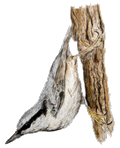
- Sherry Wine:
- Production
- Classification
- Cities & Bodegas
- Tastings
- Analogues
- Authors & Contacts
- –усский сайт
Sherry analogues
Malaga
Olga Nikandrova and Denis Shumakov.
The distance covered in a two-day walk
There are three D.ќ.s in the Province of Málaga (capital city — Málaga, located in Andalusia). D.O. Málaga regulates the production and marketing of strong (not always fortified) wine which in fact is called malaga. D.O. Sierras de Málaga (which geographically coincides with D.O. Málaga) regulates dry wine. And D.O. Pasas de Málaga, as you may guess, works with raisins. All matters relating to the activities of the three D.O.s, are administered by a single regulatory body: Consejo Regulador de las Denominaciones de Origen Málaga, Sierras de Málaga y Pasas de Málaga. But in this article of the three D.O.s we are going to address only the first one.
Malaga (wine, not the town this time) is made from Moscatel and can be either fortified or non-fortified. Non-fortified malaga, in its turn, can be either dry or sweet. Dry non-fortified malaga differs from dry wines produced under D.O. Sierras de Málaga regulations in a relatively higher alcohol level of the former (15° or more, which is achieved due to a high level of sugar in the must). Sweet non-fortified malaga can be made from over-ripe or raisined grapes... Is it becoming difficult not to lose the track? Wait, there’s still fortified malaga coming.
There are three types of fortified malaga, depending on the type of raw materials used and the time the fortification was done. Natural sweet wine (Vino dulce natural) is made from fresh ripe grapes and is fortified during fermentation (naturally, the fortification then stops this fermentation). ‘Maestro’ type of wine is also made from fresh ripe grapes, but it is fortified before the fermentation. In this case only a little alcohol is added and the fermentation doesn’t stop, but slows down, retaining residual sugar in the wine. And, finally, ‘Tierno’ type of wine is made from raisined grapes and fortified during the fermentation (which, surely, stops after the fortification is done).
In addition, malaga is classified by maturation time (which usually takes place in the “solera and criaderas” system). Wines matured less than 6 months are called Pálido (“pale”) or do not have an age marker on their labels at all (just Malaga). Wines aged up to 3 years are classified as Noble (“noble”), aged up to 5 years — Añejo ("matured“).And, finally, those aged more than 5 years are classified as Trasañejo (“very matured”).
But that is not all. Malaga can be tinted (and sweetened, at the same time) with a special syrup (Arrope — similar syrup is used in the production of some sherries). So, malaga can also be classified by color. It can be Dorado (“golden”) — uncolored, Rojo Dorado (“red golden”) — with no more than 5% of syrup added, Oscuro (“dark”) — 5-10% of syrup, Color (“colored”) — 10-15% and, finally, Negro (“black”), with more than 15% of syrup.
Moreover, there are special names for certain popular types of malaga (e.g. Pajarete — relatively sweet fortified wine produced without syrup and aged for at least two years) or malaga made of extra high quality must (Lacrimae Christi, “Christ’s Tears” — wine made of first press must aged for minimum two years). And special names for wines intended primarily for the British market (Cream, Pale Cream, Pale Dry, Seco, Abocados, etc. — these wines are different in sugar content). Plus different commercial epithets and additions, like a traditional Spanish word Viejo.
Finally, within the malaga production zone regulated by D.O. Málaga, there are five subregions: Axarquía, Montes de Málaga, Norte, Manilva and Serranía de Ronda — and, naturally, each of them has its own unique soil and weather conditions which influence the character of wine. This may also be indicated on the label.
Such an exuberant classification has an absolutely natural, in our view, outcome: winemakers often ignore this classification and write on their malaga’s labels something very simple on their own behalf.
Fortified malaga is more widespread on the market — it is sweet, dark, simple, and unceremoniously dessert. It’s gastronomic role is the same as that of sweet sherries and other similar wines.
In Russia, malaga is known a long time. Established habit of drinking malaga is attributed to Catherine the Great, but, alas, this affection is now difficult to verify. But the love to malaga of the Russian literary Bohemia of the early 20th century can be proved by documents. For example, a Russian poet Igor Severyanin characterized another Russian poet Konstantin Fofanov as “walking malaga”, and a satirist Arkady Averchenko wrote a line about Spaniards (“their attitude towards wine can be characterized by the fact that they even gave the names Jerez and Malaga to their best cities”).
but for us, in our sherry context, malaga is interesting respect of its three intersections with sherry: the same grape variety, fortification and dynamic ageing.
In short, it’s a must drink. Though a little bit (in Russian):
Ч Malaga Cruz
Warning!
This site can contain information about drinks excessive consumption of which may cause harm to health and is unadvisable for people who didn’t come of age.
Share Sherry
- Sherry.wine, FEDEJEREZ
- Copa Jerez, Sherry Week
- Sherry Notes, Jerez de Cine
- Los Generosos, Criadera
- Jerez-Xeres-Sherry
- Los Vinos de Jerez
Articles
- There are more articles in Russian than in English in this website. Sorry :(
Reviews
- To our great regret, we didn’t have time to translate tasting and traveling notes into English. But, if you want, you can see them in Russian.

